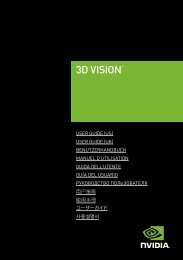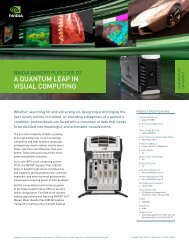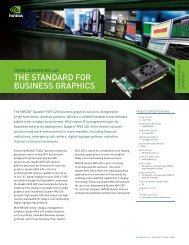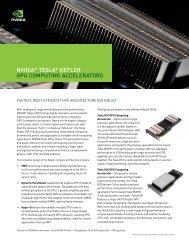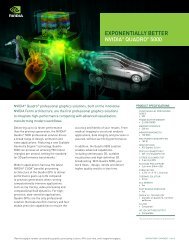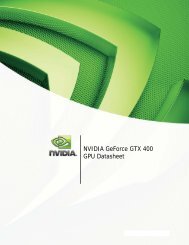Tegra 4 Whitepaper - Nvidia
Tegra 4 Whitepaper - Nvidia
Tegra 4 Whitepaper - Nvidia
- No tags were found...
Create successful ePaper yourself
Turn your PDF publications into a flip-book with our unique Google optimized e-Paper software.
P a g e | 91x DP4 + MFUA total of 16KB of Pixel Cache is divided into four 4K L1 cache slices depicted in thearchitecture diagram, and can reduce off-chip framebuffer access by over 50% in some cases.Similar to prior NVIDIA ® <strong>Tegra</strong> ® processor’s previous GPUs, the <strong>Tegra</strong> 4 processor’s GPU usesFP20 pixel shader precision for power efficiency. In our studies, differences in image qualitybetween FP32 and FP20 pixel rendering are virtually unperceivable to the human eye, and thepower savings is substantial to warrant using FP20 in this generation SoC.Separate vertex and pixel shader architecture, rather than unified architecture, is also used forpower efficiency reasons. The power savings derived from separate vertex and pixel shaders inthe <strong>Tegra</strong> 4 processor architecture outweigh the workload flexibility advantages of unifiedshaders.Texture Filtering UnitsEach pixel shader unit also includes a Texture filtering unit capable of FP16 texture filtering,which enables High Dynamic Range (HDR) rendering. The four texture units each have theirown L1 cache, and a 16K L2 texture cache (in both <strong>Tegra</strong> 4 and 4i processors) improvesperformance by reducing texture fetches from external memory. Because of the typical localityof texture memory accesses by the four texture units, the combination of L1 and L2 texturecaches reduces off-chip texture accesses by over 80% in most cases.Similar to prior <strong>Tegra</strong> processor’s GPU, the <strong>Tegra</strong> 4 processor implements very high quality 16xanisotropic filtering. Anisotropic filtering is a technique employed to enhance the image qualityof textures on surfaces that are at oblique viewing angles. Each pixel on the screen typicallyrequires multiple texture elements to be fetched from texture maps in memory, filtered, andapplied to the pixel to change its color. When viewing a surface head-on, perpendicular to thecamera or viewer, an equal number of texture elements are usually sampled per pixel using asquare sample pattern. However, at extreme viewing angles when the image on the screenextends further along one axis than another, taking equal number of samples in each axis fromthe texture map would result in texture blurring along the axis that stretches out into the horizon.In the image with the two runways in Figure 4, texture detail is blurred in the right runway forsections that are closer to the horizon. The runway on the left has Anisotropic Filtering applied,and you can see that the texture detail has improved significantly, as more texture samples aretaken along the axis that is stretched out. Similarly, you can see differences in sharpnessbetween 2x vs 16x Aniso in the test pattern. Adaptive filtering algorithms and efficient texturecache management techniques deliver high texture quality without significantly increasingmemory transactions.NVIDIA <strong>Tegra</strong> 4 GPU Architecture February 2013



